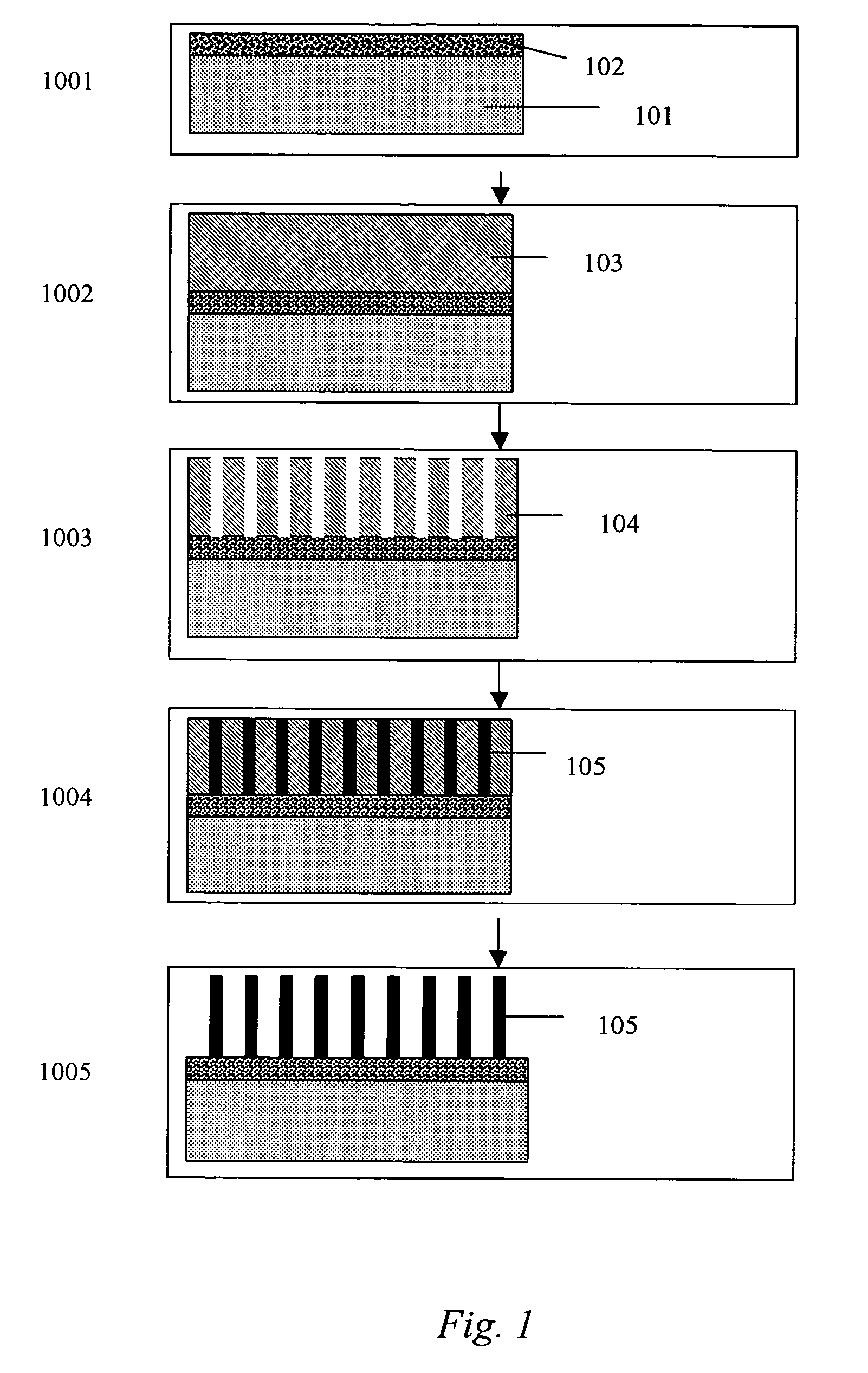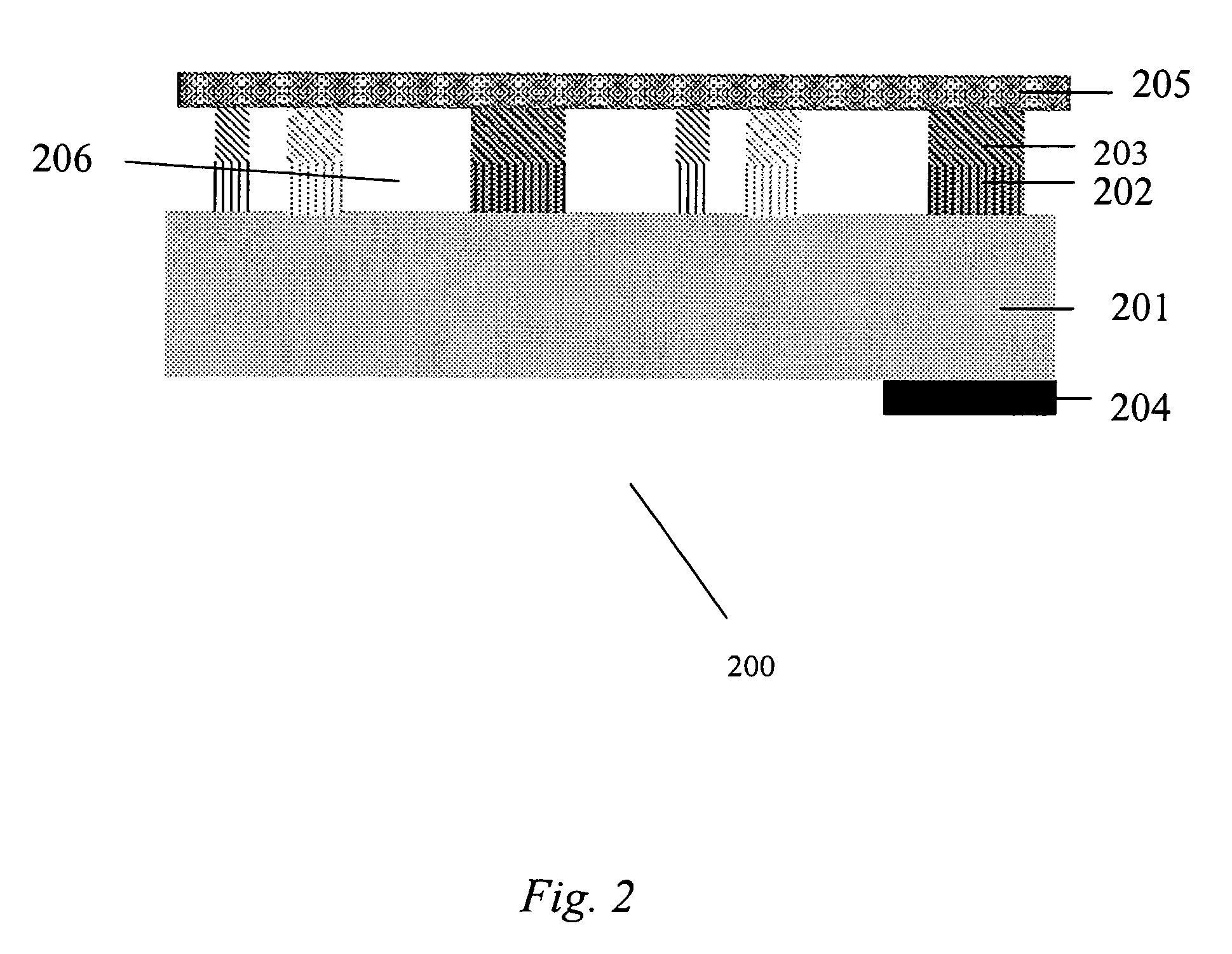Monolithic light emitting devices based on wide bandgap semiconductor nanostructures and methods for making same
a nanostructure, monolithic technology, applied in the field of nanolithography, can solve the problems of low quality, low cost effective and low-defect materials, and high density of threading dislocation, and achieve the effects of low cost, reduced defects, and high degree of size control and/or uniformity
- Summary
- Abstract
- Description
- Claims
- Application Information
AI Technical Summary
Benefits of technology
Problems solved by technology
Method used
Image
Examples
example 1
[0075]This example serves to illustrate the role modeling plays in determining optimum material selection for the wide bandgap material nanostructures and the substrate / nucleation layer.
[0076]A three-dimensional model has been developed to help predict and optimize the nano-template chemical composition, geometry, and dimensions for which low-defect wide band gap nanostructures are obtained. The models for misfit dislocation nucleation are formulated with the aid of numerical finite element simulations and approximate dislocation energetics, and are an extension of the Jain and Atkinson models for 2-dimensional stripes into 3-dimensions (Atkinson et al., J. Appl. Phys., 72, p. 2242, 1992); Jain et al., J. Appl. Phys., 78, p. 1630, 1995; Atkinson et al., J. Appl. Phys., 77, p. 1907, 1995). One of the outputs of the model is a dislocation density map for various nano-island chemical composition, shape, and dimension combinations. In particular, critical combinations (i.e., cylinder ra...
example 2
[0078]This example serves to illustrate the nanolithographic process using block co-polymer lithography as an exemplary nanolithographic means.
[0079]Referring to FIG. 6, a self-assembled block co-polymer thin film 601 (e.g., PS-PMMA) is deposited on top of the sacrificial dielectric layer 103 in step 6001. Selective removal of one of the block co-polymer phases with chemical and / or radiation treatments yields a nano-lithographic mask composed of a nano-porous polymeric film 602, as shown in step 6002. In step 6003, chemical treatment and / or reactive ion etching (RIE) and pattern transfer to the sacrificial layer yields the nano-porous template or mold 104 in which wide bandgap material nanostructures 105 can be grown as in step 6004. FIG. 7 depicts a scanning electron micrograph of a surface that has been patterned using block co-polymer lithography.
example 3
[0080]This example serves to illustrate the effect of surface elasticity on the emission properties of “embedded” wide bandgap nanostructures.
[0081]As mentioned in the background section, at the nanoscale, size-related quantum confinement effects have a large influence on the emission wavelength of light. Applicant has recently demonstrated that surface elasticity (nano-strain) effects at the nanoscale level can also cause a dramatic shift in the emission wavelength of embedded quantum dot nanostructures (Sharma et al., Phys. Stat. Sol. B, 234(3), R10–R12 (2002); Sharma et al., “Effects of Surface Elasticity in Nano-Inhomogeneities, Nanocomposites, and Quantum Dots,” ASME Mechanics of Materials Conference, Scottsdale, Ariz. (2003); both of which are incorporated herein by reference). Hydrostatic strain state within a QD structure is known to impact that structure's optoelectronic properties. Several works, of varying sophistication (both analytical and numerical), have focused on th...
PUM
| Property | Measurement | Unit |
|---|---|---|
| thickness | aaaaa | aaaaa |
| pore radii | aaaaa | aaaaa |
| pore radii | aaaaa | aaaaa |
Abstract
Description
Claims
Application Information
 Login to View More
Login to View More - R&D
- Intellectual Property
- Life Sciences
- Materials
- Tech Scout
- Unparalleled Data Quality
- Higher Quality Content
- 60% Fewer Hallucinations
Browse by: Latest US Patents, China's latest patents, Technical Efficacy Thesaurus, Application Domain, Technology Topic, Popular Technical Reports.
© 2025 PatSnap. All rights reserved.Legal|Privacy policy|Modern Slavery Act Transparency Statement|Sitemap|About US| Contact US: help@patsnap.com



